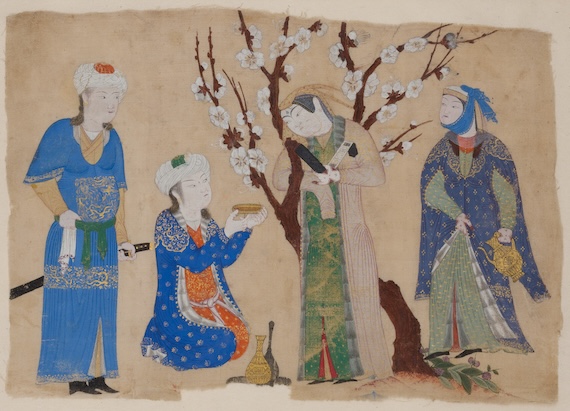The fourth quatrain in Edward FitzGerald’s 1859 first edition of The Rubáiyát of Omar Khayyám is:
IV
Now the New Year is reviving old Desires,
The thoughtful Soul to Solitude retires,
Where the WHITE HAND OF MOSES on the Bough
Puts out, and Jesus from the Ground suspires.
اکنونکه جهانرا بخوشی دسترسیست
هر زنده دلی را سوی صحرا هوسیست
بر هر شاخی طلوع موسی دستیست
در هر نفسی خروش عیسی نفسیست
This is 13 of the Bodleian manuscript and #12 in my The Rubáiyát of Omar Khayyám, a New Translation from the Persian, which also has a fascinating historical exploration of where this poetry came from and its influence through the ages.
Heron-Allen’s literal translation is:
Now that there is a possibility of happiness for the world,
every living heart has yearnings toward the desert;
upon every bough is the appearance of Moses’ hand;
in every breeze is the exhalation of Jesus’ breath.
Transliteration:
aknun ke jahanra bekhoshi dastrasist,
har zendeh deli ra suye sahra havasist.
bar har shakhi tolu-e musa dastist,
dar har nafasi khorush-e isa nafsist.
—-
Order Juan Cole’s contemporary poetic translation of the Rubáiyát from
or Barnes and Noble.
or for $16 at Amazon Kindle
——-
I explained elsewhere,
This is a poem with overtones of the Persian New Year, which falls on the Spring Equinox around March 21 and so coincides with the advent of spring.
Trees with white blooms like our magnolias or elderberries are being compared here to the miraculous white hand of Moses. Turning his hand white was one of his divine signs that God instructed the Hebrew prophet to use when he confronted Pharaoh:
Exodus 4:1,6-7
- “Then Moses answered, “But suppose they do not believe me or listen to me, but say, ‘The Lord did not appear to you.’… Again, the Lord said to him, “Put your hand inside your cloak.” He put his hand into his cloak; and when he took it out, his hand was leprous,[a] as white as snow. Then God said, “Put your hand back into your cloak”—-so he put his hand back into his cloak, and when he took it out, it was restored like the rest of his body—-”
This miracle is also mentioned in the Qur’an, and Persian poetry refers to it as a sign of renewal, since Moses can reverse the condition at will.
The other reference is to Jesus’ ability to raise the dead, as in Luke 7:11-14
- “11 Soon afterward he went to a town called Nain, and his disciples and a large crowd went with him. 12 As he approached the gate of the town, a man who had died was being carried out. He was his mother’s only son, and she was a widow, and with her was a large crowd from the town. 13 When the Lord saw her, he was moved with compassion for her and said to her, “Do not cry.” 14 Then he came forward and touched the bier, and the bearers stopped. And he said, “Young man, I say to you, rise!” 15 The dead man sat up and began to speak, and Jesus[c] gave him to his mother. “
This poetry takes a dim view of people who put off achieving their hearts’ desires. It is very much a poetry of “seize the day.” It advises against letting yourself lose hope, and urges that you express life-fulfilling passion.”
In this series:
FitzGerald’s Rubáiyát of Omar Khayyám 1:1
“Awake my little ones and fill the Cup!” FitzGerald’s Rubáiyát of Omar Khayyám 1:2
“Those who Stood before the Tavern” – FitzGerald’s Rubáiyát of Omar Khayyám 1:3
Now the New Year is Reviving old Desires: FitzGerald’s Rubáiyát of Omar Khayyám 1:4
“But still the Vine her ancient Ruby Yields:” Fitzgerald’s Rubáiyát of Omar Khayyám 1:5
“Red Wine!” – the Nightingale cries to the Rose: FitzGerald’s Rubáiyát of Omar Khayyám 1:6



 © 2026 All Rights Reserved
© 2026 All Rights Reserved